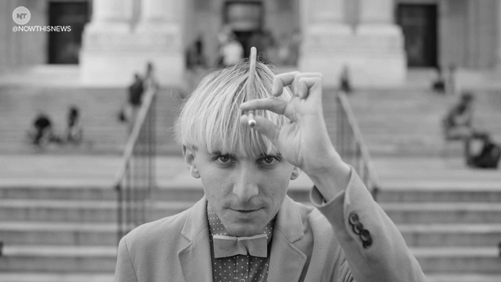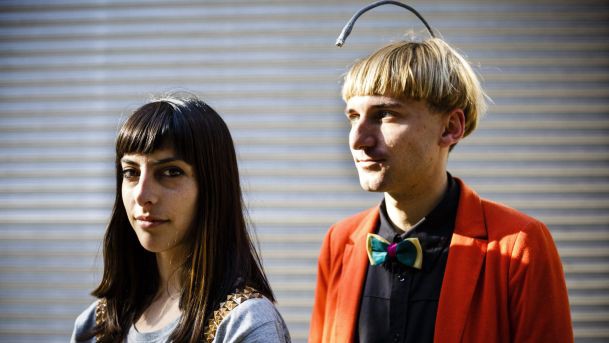Our future: interview with cyborg

Source: original article
Neil Harbisson and Muna Ribas - how we should change in order to reach the maximum of our own potential.
The word "cyborg" is familiar to every lover of science fiction, but Neil Harbisson and Muna Ribas, a couple of "cyborg activists" from Catalonia, argue that they have never been interested in the literary component.
Active and creative individuals, they are trying to return the original, “scientific” meaning to the term — associated with the idea of conquering alien space and overcoming inherent limitations — in order to become closer to nature through technology
')
"The Way Up" for Humanity
In 1960, Manfred E. Clyns and Nathan S. Klin published an article entitled Cyborgs and Space , which pointed to the importance of technoevolution, which would make it possible not only to explore cosmic expanses, but also to live there like a fish in water. Cyborg, as a combination of KIBERNETIC and ORGANIC, is capable of duplicating the skills of other living organisms, their organs, and perception channels in order to go beyond the biological framework, rather than transform the alien environment for themselves. Quoting the original article, “cyborg deliberately adds additional external components to itself, expanding the range of adaptation of its own systems to the new environment.”
This concept is promoted by Harbisson and Ribas, integrating the advanced achievements of science into performed performances.
Nile, famous for the “antenna” and the title of “the first officially recognized cyborg”, was born color blind, however, he can now recognize colors through an implant that turns a color into vibrations. This happened a long time ago, in 2003, when he worked with IT specialist Adam Montadon at the Darington College of Art (England). Inspired by the way dolphins communicate using electromagnetic waves ( note a translator: probably a journalist's mistake. The language of dolphins is based on body position in space and ultrasonic signals ), Neil created a way to “hear” color, receiving not only a kinesthetic sensory channel, but also a completely unusual "look" on the environment.
In a similar way, Muna Ribas made the performances as a dancer and performance artist more expressive with the help of an implant embedded in the elbow. This seismic sensor allows a girl to sense earthquakes, wherever she is. Merging with an unknown sensation until now, Muna invented the dance “Wait for the earth to shudder”, in which she moves in accordance with the power and duration of the earthquake that she felt at the time of the show.
Together with Harbisson, Ribas created the Cyborg Foundation , a non-profit organization, and also launched the Cyborg Nest online store, where you can buy a personal implant and embed it in the body of a piercing master.
Using these initiatives, Harbisson and Ribas want to make cyborgization more ordinary and accessible.“We receive a lot of emails from teenagers who want to become cyborg and rebuild their bodies,” says Ribas. “They are ready to experience the world not only by their usual methods.”

Source: original article
Inevitable change
If Harbisson believes that certain steps should be taken now to popularize the topic, then Ribas, on the contrary, is confident that cyborgization is inevitable in the future in any case.
“Technology will be in the bodies of people, not just as a tool, but as part of their being,” she says.
At the moment, the main problem is the ethical process. According to Neil, the medical professional community does not accept cyborg surgery for bioethical reasons, especially after realizing the fact that the procedure for introducing devices is much easier than it seemed. But even if you found a surgeon who agrees to perform an operation, you can hardly count on a warm reception in the society after you change.
“Many groups of people see us as a threat, considering the augmetization a loss of humanity. And there is no way to get rid of such remnants, ”says Harbisson.
The position of the duet in this matter is very specific and deliberate. They are convinced that the use of technology solely as a tool not only alienates us from nature, but also from each other. “Let's say mobile phones. Everywhere there are people who have stumbled upon the screen and are walking along the street, seeing nothing and not hearing. If this is the gap between individuals, it is not difficult to figure out how big the gap is between the outside world and society, ”explains Harbisson.
In his opinion, “technology is too distracting from what is happening,” but “if we ourselves become technology, then we can focus again on what is around us.”In other words, Harbisson and Ribas are trying to breathe new life into the slogan of Klin and Kleins that “cyborg is a step forward.” In early September, they traveled to Brazil to collaborate with Mesa & Cadeira, an agency that formed teams of specialists to solve specific problems. This time, the guys had to work with a team of 15 professionals, including an engineer, a dentist and a dancer, for six days.
The result was a dental implant called WeTooth, equipped with a radio module for receiving and transmitting Morse code. During the performance in Sao Paulo, the couple sat back to back at the table, but each of them could find out what she saw of the other, receiving messages through the implant vibration, like elephants talking at long distances, stamping their feet on the ground.
Expansion of perception will lead to the development of knowledge
As Harbisson stated during his speech at TED in 2012 , “everyone will want to improve their own senses, if they find the courage to admit how much our capabilities are reduced compared to some animals.” “Sharks can detect electromagnetic fields,” recalls Nil, “Dolphins hear through bones, bats have echolocation. By becoming cyborg, we get a chance to "look" at the world "through the eyes of" other species. "
Cyborg activists believe that in this way our understanding of the world will become more "natural." When the conversation about WeTooth started again, Harbisson said that the implant will be upgraded to make a global connection. “We are going to a transhuman, ” he laughs, “But indeed, we have always been on this road since the first protocell.”

Source: original article
Of course, the desire for progress through the modification of the body and the senses is commendable, but one should not forget about the harm to the environment. “Many of our methods for nature are not very pleasant,” sighs Harbisson.
For example, in his opinion, there is no need for electric lighting, if you see in the dark. “In order not to use lighting engineering everywhere, it would be much smarter to transform itself, and thus change not only yourself, but also the situation around, and the entire planet”
Many dystopias like the book "On the Brave New World" by Aldous Huxley (1932) argued that technology is not just harmful, but threatens the very essence of our species, describing the classic confrontation of "culture-naturalness." The same Huxley, using an advanced version of the “noble savage” archetype, painted pictures of a terrible future, where “civilized” people are not only incredibly divided by caste separation, but also completely divorced from reality by mass entertainment and the constant use of the soma drug.
The manner of Harbisson and Ribas in promoting the principle of “back to nature” may seem something similar, but they do not call for the destruction of all mechanisms, becoming some kind of “non-Luddites”. Their desire is only to “fill technologization with meaning,” as well as teach them to recognize what is “real” and what is not, in conditions of ever-increasing “digitization”.
To the question “is it interesting to them to use virtual reality in projects or presentations?” The guys responded that they would prefer to “complement” reality ( AR, augmented reality ) with the use of HoloLens , receiving, as they call it, “Real Reality”. “There are technologies, like my antenna or the moon seismic sensor, which allow us to sense phenomena that objectively exist, but which are inaccessible to the" ordinary "person," Nil gives an example.
And if there is a choice between the "Wirth" and "upgrade", they will undoubtedly choose the second. “By adding layers to the setting or, on the contrary, removing, you change the experience you experience depending on the context, and virtuality, unlike augmented reality, isolates the context from the user, we do not like it,” says Harbisson, “BP is not very effective at all, but if there are no other options, you can use it. "
What's next?
And although Neil Harbisson and Muna Ribas, as mentioned above, are not interested in science fiction, instead using real scientific research as a base, not least the relevance of their work has been growing thanks to the cyborg-heroes of science fiction stories of the last few decades. These characters walked the distance from the first mention in Martin's The Cyborg by Martin Kaydin in 1972 to Donn Harawei's Cyborg Manifesto , which summarized a number of ideas that were important for philosophy, sociology and art on this subject in one piece. And a little later, things like Statrek, Star Wars or the Gibson trilogy Cyberspace showed us that being a cyborg is also “cool.”
In order to know and understand the world around us, people in their history have created and spread an incalculable number of myths and legends; Considering this fact, I think that it is worth counting from the point of appearance of the meanings embedded in the term “cyborg” by science fiction, the next era in which to be a cyborg is “normal”.
At the Human by Design conference organized by the developers of Deus Ex: Mankind Divided on August 3, Harbisson finally got a chance to get acquainted not only with the desire to provide cyborgs with new ethics, but also with an attempt to change their perception through video games and publications in the media. Hopefully, the world will finally become clear all the huge potential of "cyborgization", thanks to the work of ardent supporters of science fiction, and the work of people like Muna and Nil.
Source: https://habr.com/ru/post/371393/
All Articles